Y-12 Blog
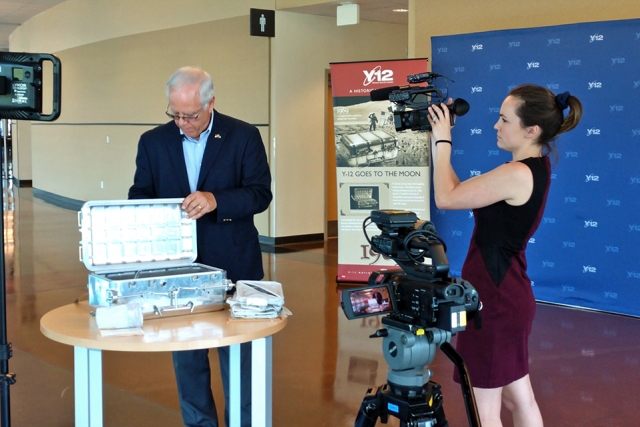 Paul Wasilko shows Emily DeVoe of WBIR one of the moon boxes built at Y-12 for the Apollo missions.
Paul Wasilko shows Emily DeVoe of WBIR one of the moon boxes built at Y-12 for the Apollo missions.
“The biggest benefit of Apollo was the inspiration it gave to a growing generation to get into science and aerospace.” – Buzz Aldrin, Lunar Module Pilot, Apollo 11
Who didn’t once dream of being an astronaut in the 1960’s? Paul Wasilko of Program Integration certainly did. In fact, he was quite disappointed to be attending the annual Boy Scout Jamboree in Idaho with 34,000 other scouts in July 1969 when the moon landing was going to occur.
Paul did get to see the moon landing … with narration by astronaut Frank Borman and a special greeting from astronaut and fellow Eagle Scout Neil Armstrong live from the moon. The scout who watched that moon landing now has his own tie to Apollo 11 history—sharing how Y-12 played an important role in that mission 50 years ago.
In 1967, Y-12 produced 16 moon boxes, or Apollo Lunar Sample Return Containers, for NASA to safely handle the lunar material. It also provided support to the design of the Lunar Receiving Laboratory to process the samples brought back from the moon.
The moon boxes were not the first collaboration with NASA. A few years earlier, Y-12 built blood sample containers for Gemini as part of a study to determine if space flights adversely affected human blood. (Spoiler alert: It doesn’t.) That project, which was known as Blood in Gemini, was the start of a beneficial partnership between the agencies.
As we reflect on the past, it’s always good to look forward. Today, our partnership with NASA is focused on fueling the next space mission through demonstrations like KRUSTY (Kilopower Reactor Using Stirling TechnologY) or nuclear thermal propulsion. Morris Hassler and Chris Robinson of Global Security and Strategic Partnerships are leading Y-12’s work in those areas.
From past to present and future, a WBIR special airing on Tuesday, July 16, will celebrate the 50th anniversary of Apollo 11, including the role Oak Ridge and Y-12 played and continues to play in exploring the final frontier. Be sure to tune in on Tuesday. You might see some familiar faces.
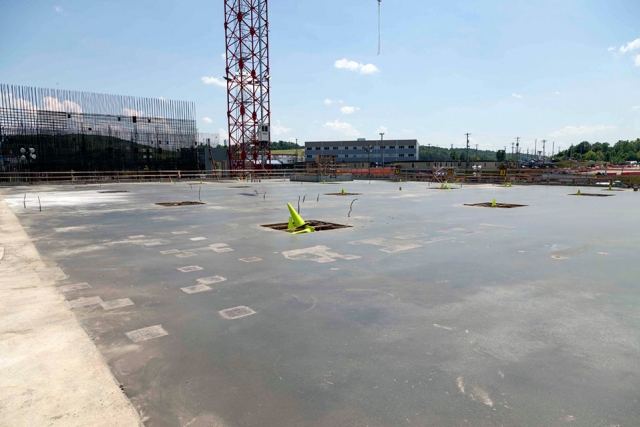 The final topping slab was placed at the Salvage and Accountability Building allowing structural steel installation to take the building vertical. Foundations for all UPF main buildings were completed ahead of schedule.
The final topping slab was placed at the Salvage and Accountability Building allowing structural steel installation to take the building vertical. Foundations for all UPF main buildings were completed ahead of schedule.
When the final topping slab for the Salvage and Accountability Building was placed it marked a major milestone for the UPF project – all foundations for the main UPF buildings were complete. The UPF team completed this milestone ahead of schedule.
“There were no major challenges to the SAB final placement other than the sheer size of the slab, which was about 17,000 square feet,” said Deputy Area Manager Randy Holman. “The prep work accomplished by the civil team set up the concrete placement team for success.”
The final topping slab placement was carefully coordinated. It took 11 concrete trucks a total of 92 trips back and forth between the onsite concrete batch plant and the SAB. The close proximity of the batch plant had major benefits for a placement of this size. The subcontract technical representative could quickly travel between the site and batch plant to personally oversee quality, and fewer trucks were needed because they made quicker runs.
The final placement required 885 cubic yards of concrete and was completed during a night shift. Placing concrete at night allowed the finishers to work during the daytime; concrete hardens quicker in the sun with the daytime heat than in the cooler evenings, so finishing work was completed in a shorter period of time. Working through the night resulted in less construction site traffic and congestion, which reduced the potential for concrete delivery delays as the trucks travelled between the batch plant and project site.
“Completing this milestone enabled us to begin SAB structural steel installation with the initial 17,000 pound, 60 foot steel columns,” said SAB Federal Project Director Don Peters.”
| Fast Facts | |
|---|---|
|
Did you know? Base slab vs. topping slab |
The base slab is the main structural slab designed to carry the entire building load, which is why the structural anchor bolts are embedded in the base slab. The topping slab is an additional slab with embeds that allow equipment to be attached. The base slab is constructed first, and the topping slab is constructed on top of the base slab. | Salvage and Accountability Building |
| Base Slab | 9,000 cubic yards |
| Topping Slab | 2,300 cubic yards |
| Main Process Building | |
| Base Slab | 23,000 cubic yards |
| Topping Slab | 4,500 cubic yards |
| Mechanical Electrical Building | |
| Base Slab | 5,500 cubic yards |
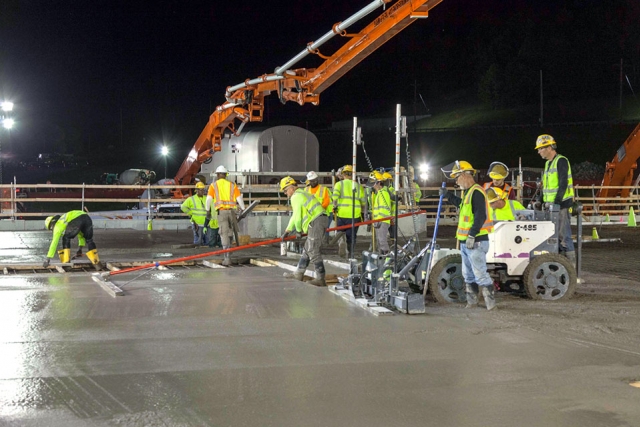 Concrete crews place 885 cubic yards of concrete during a night shift at the Salvage and Accountability Building.
Concrete crews place 885 cubic yards of concrete during a night shift at the Salvage and Accountability Building.
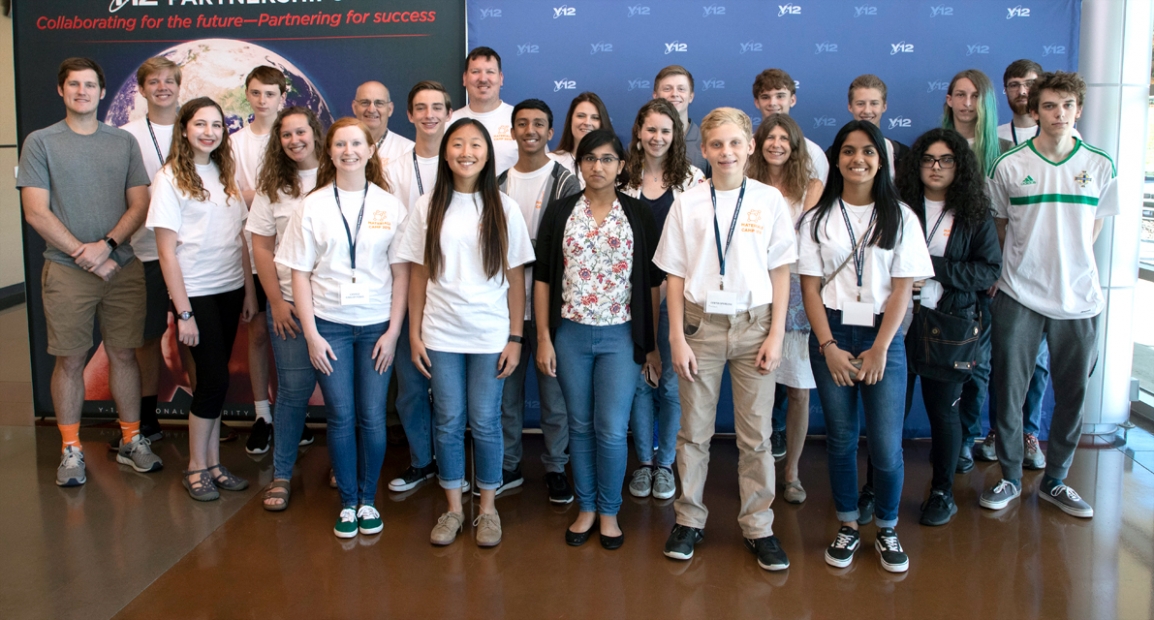 Materials Camp participants, their instructors, and University of Tennessee student volunteers at the Y-12 National Security Complex’s New Hope Center.
Materials Camp participants, their instructors, and University of Tennessee student volunteers at the Y-12 National Security Complex’s New Hope Center.
To understand how and why things work, sometimes you have to take a close look. A really close look. Avery, a Roane County High School senior, did just that at this summer’s Materials Camp, sponsored in part by the Y-12 National Security Complex.
She and 14 other East Tennessee high school students studied nickel, iron, aluminum, copper, and other metals not by opening a textbook but by heating, hammering, grinding, bending, rolling, and polishing the materials.
“We learned how these materials behave under certain conditions and stresses,” Avery said. “Then we examined their microstructures, the different grain structures, using a scanning electron microscope and other analytical equipment.”
One of the campers’ favorite activities was pounding a hot iron bar with a forging hammer during the blacksmithing demonstration. “That was really fun and cool,” said Avery, who wanted to make sure everyone, including her camp instructors, got in a few whacks at the bar.
“Avery wasn’t going to let us leave until I had a chance to take out some aggression on that metal bar,” said Dr. Claudia Rawn, one of the camp coordinators and associate professor in the University of Tennessee’s Materials Science and Engineering department and director of UT’s Center for Materials Processing.
Having fun while learning is all part of the camp formula. Through hands-on activities and an escape- room scenario, camp instructors introduced students to materials science, which involves the properties of materials and their application in everything from high-performance electronics and airplanes to stents, heart valves, and other biotechnologies to renewable energy.
“I think all of the students now have a different view that everything is made of a variety of materials and there are opportunities to have a fascinating education and career with materials,” said camp coordinator Bob Bridges, a Y-12 metallurgist.
Before the weeklong camp, many of the students had never heard of materials science. “Most high school students thinking about majoring in an engineering discipline don’t know about materials science and engineering,” Rawn said. “A lot of STEM-oriented students know they want to major in engineering, and knowing about materials science and engineering helps them to make a more informed choice.”
The camp not only serves as a recruiting tool for area colleges but also feeds the workforce pipeline. Y-12 sponsors the camp as part of its educational outreach efforts to develop the science, technology, engineering, and math skills the site will need in the future.
“Because of this camp, I’m thinking about pursuing an education in materials science,” Avery said. “It got me thinking about different avenues for college and a career.”
In addition to UT and Consolidated Nuclear Security, which manages and operates Y-12 for the National Nuclear Security Administration, camp sponsors included the ASM Materials Education Foundation and Pellissippi State Community College.
Electron Optics Instruments and IXRF Systems, Shimadzu Scientific Instruments, Mager Scientific, and Carl Zeiss Microscopy provided almost $400,000 worth of equipment for students to use as well as staff to train campers on how to use it.
“This camp would not be possible without the huge number of volunteers who work with the students behind the scenes and donate equipment and provide expertise,” said Teri Brahams, executive director for Economic and Workforce Development at Pellissippi State Community College.
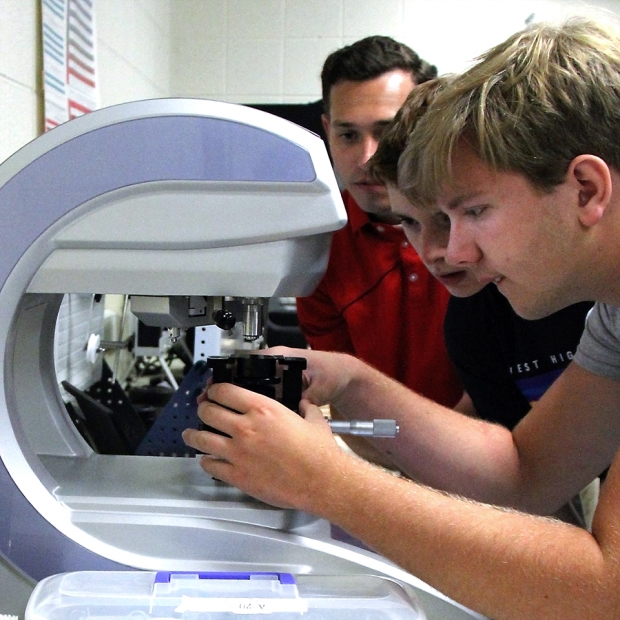 Materials Camp students use a hardness tester to compare the relative hardness of a control sample to an unknown heat-treated sample.
Materials Camp students use a hardness tester to compare the relative hardness of a control sample to an unknown heat-treated sample.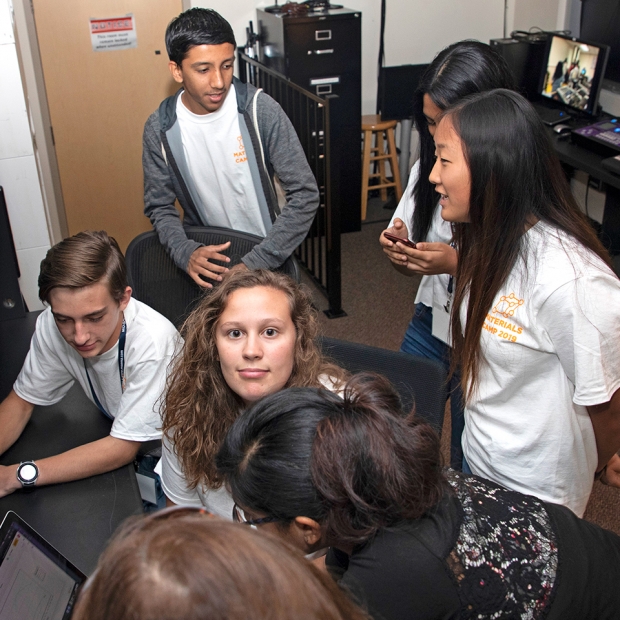 Roane County High School senior Avery (center) and other Materials Camp students work on their presentation for the final day of camp. Materials Camp “got me thinking about different avenues for college and a career,” said Avery, whose father is an electrician at the Y-12 National Security Complex.
Roane County High School senior Avery (center) and other Materials Camp students work on their presentation for the final day of camp. Materials Camp “got me thinking about different avenues for college and a career,” said Avery, whose father is an electrician at the Y-12 National Security Complex.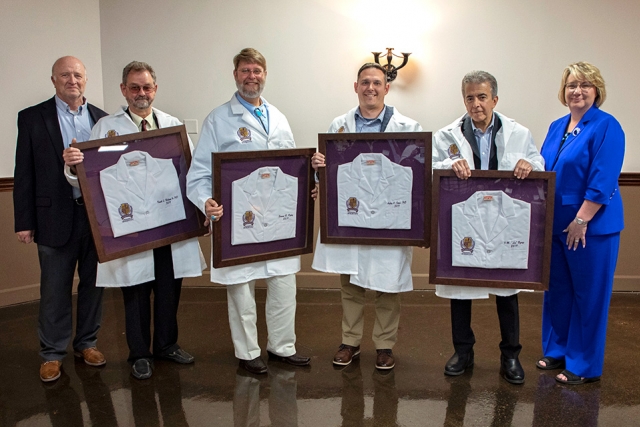 Consolidated Nuclear Security’s Dave Beck, vice president of Program Integration, and Michelle Reichert, chief operating officer, congratulate Y-12 League of Ingenuity inductees, second from left, Rusty Hallman, Ed Ripley, Ashley Stowe, and Lee Bzorgi.
Consolidated Nuclear Security’s Dave Beck, vice president of Program Integration, and Michelle Reichert, chief operating officer, congratulate Y-12 League of Ingenuity inductees, second from left, Rusty Hallman, Ed Ripley, Ashley Stowe, and Lee Bzorgi.
At the Y-12 National Nuclear Security Complex’s Technology Transfer awards ceremony held in May, Consolidated Nuclear Security introduced the League of Ingenuity, a new merit-based society to recognize Y-12 and Pantex employees who have notable technical and innovative accomplishments.
CNS manages and operates Y-12 and the Pantex Plant in Amarillo, Texas, for the National Nuclear Security Administration.
“The nation benefits when Pantex and Y-12 engage in technology transfer because the technologies we develop in support of our mission requirements often have broader utility and impact,” said Tom Berg, CNS director of Technology Development and Transfer Programs.
The League of Ingenuity acknowledges employees who have developed mission-advancing technologies and solutions that benefit not only CNS and other government organizations but also private industry and taxpayers.
“Our team developed the society to encourage and motivate employees to pursue research and development efforts that may leverage partnerships with academia and industry partners, enhancing both Y-12’s and Pantex’s profiles as centers of scientific excellence,” Berg said.
Meet Y-12’s inaugural inductees into the League: Lee Bzorgi, Rusty Hallman, Ed Ripley, and Ashley Stowe. Pantex innovators will be recognized at a separate event.
Lee Bzorgi
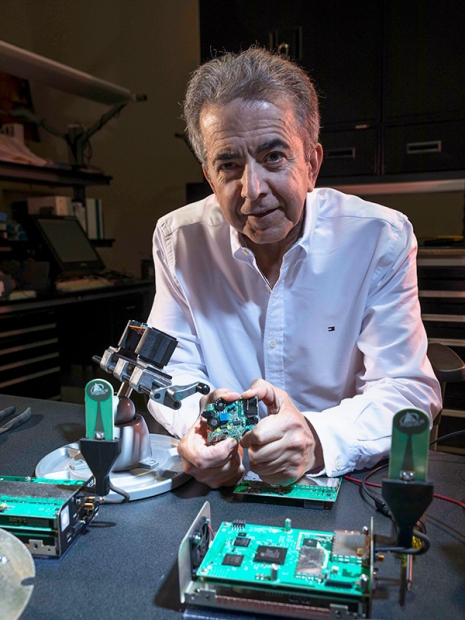 Lee Bzorgi
Lee BzorgiResearch interests: Designing and fabrication
Why I chose a career in science: As a child, I had the best toys in the neighborhood because I was building them myself. By the time I was 10 years old, I had my first design published in an engineering magazine. Getting into engineering and science was an easy decision for me.
Accolades:
- R&D 100 Award (Rapid Deployment Shelter System, 2007)
- 8 patents since 2006
- 39 invention disclosures at Y-12
- CNS Government Use Award winner in 2005, 2007, and 2009
- Featured in Popular Science magazine, “The DOE’s Gadget Guru” (2003)
- Lead inventor for technologies that have resulted in multiple commercial licenses
- Won Innovation Valley Technology Council’s Pathfinder Research Entrepreneur of the Year award, 2010
Dr. Rusty Hallman
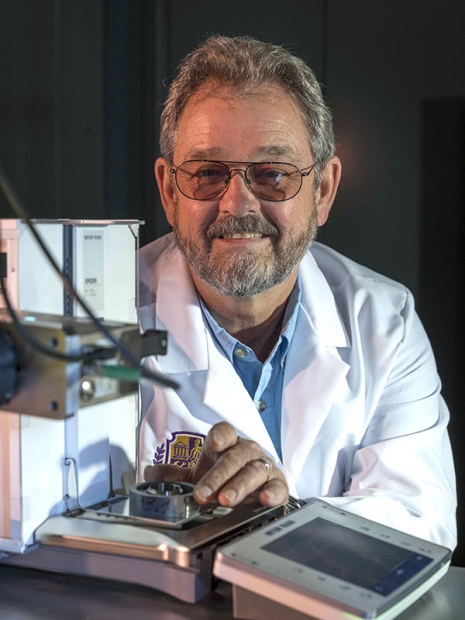 Dr. Rusty Hallman
Dr. Rusty HallmanResearch interests: Precise blending of gases and vapors to make calibration standards for the plant. These efforts have led me to the automation of corrosion studies using robotics and the integration of analytical equipment to provide insight into the complex behavior of these chemical systems.
Why I chose a career in science: I seek out problems others do not want to address. These things intrigue me. Science and engineering are just tools or systems to understand how and why things work the way they work.
Accolades:
- 9 patents since 2004
- 32 invention disclosures
- Lead inventor on a multi-year Funds-In Cooperative Research and Development Agreement
- Respected within industry for research and development efforts in moisture-blending technologies and work in mitigating tin whisker growth within the electronics industry
Ed Ripley
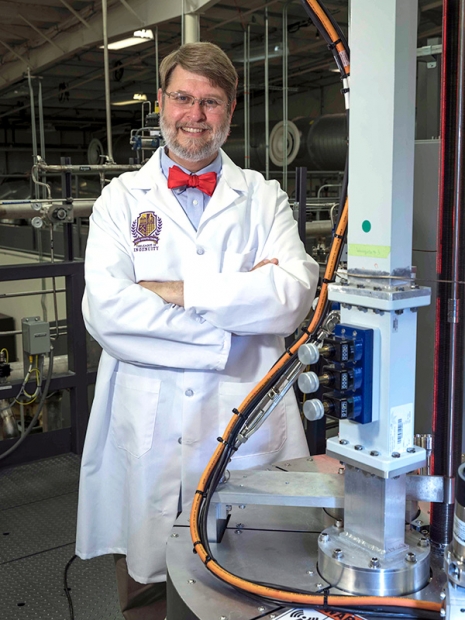 Ed Ripley
Ed RipleyResearch interests: Microwave casting, uranium metallurgy
Why I chose a career in science: I loved science as a child, and for the last 29 years, I have made a living using subtle nuances in the sciences to accomplish unexpected things. I call it “exploiting the loopholes in the laws of physics.”
Accolades:
- 27 patents and 5 in process
- 72 invention disclosures
- Completed the Sandia National Labs Weapons Intern Program
- Guest on Penn and Teller “Fool Us” television program and one of 5 close-up competitors to represent the U.S. at the world championships of magic in Busan, Korea, in 2018
- Received the Society of American Magicians “Creativity Award” in 2019
Dr. Ashley Stowe
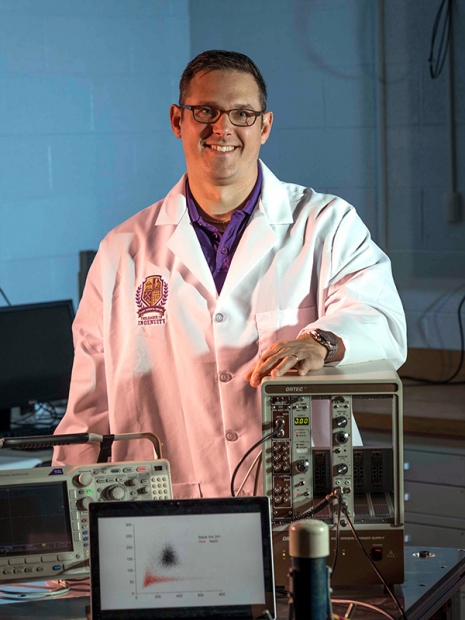 Dr. Ashley Stowe
Dr. Ashley StoweResearch interests: Space chemistry, hydrogen fuel materials, nuclear nonproliferation, radiation detection (neutron imaging technologies)
Why I chose a career in science: I learned a passion for science and discovery from my high school chemistry teacher, Dr. Greg Rushton. He showed my class the power of science and then threw us the keys to the chemical cabinet and said, “Try a few things!” A few things blew up along the way, some even on purpose, but I discovered the joy of creating new things.
Accolades:
- R&D 100 Award (LISe crystals, 2013)
- 15 patents and 1 in process
- 25 invention disclosures
- Y-12 Technology Fellow 2013–2015
- Authored more than 61 articles in peer-reviewed publications
- Joint Assistant Professor of Nuclear Engineering at the University of Tennessee, Knoxville
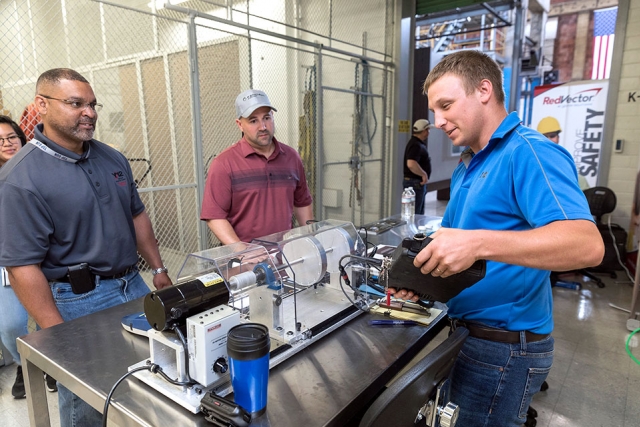 Infrastructure’s Proactive Safety Team offers Vendor Days where outside companies bring in and demonstrate safety equipment.
Infrastructure’s Proactive Safety Team offers Vendor Days where outside companies bring in and demonstrate safety equipment.
Y-12’s Infrastructure group developed a Proactive Safety Team in 2015, but they’ve never quit working to improve the program that uses a proactive approach to predict and mitigate accidents and incidents before they occur.
As Infrastructure’s Linda Fiore explained, “To quote William Blake, ‘Hindsight is a wonderful thing, but foresight is better, especially when it comes to saving lives.’”
The team has several components — Floor-Up Safety, High-Hazard Senior Review Board, Injury Review Board, PST Tool and Clothing Committee, Vendor Days, and Voice From the Floor.
Fiore said the Voice From the Floor aspect has resulted in several successful examples demonstrating the intent of the Proactive Safety Team.
“The PST process is about changing the culture from a top-down approach to safety to a bottom-up for leadership to support and encourage,” she said. “Listening to those who do the work every day is crucial because they are the ones with hands on and eyes on experience with so many places at the site.”
Each Infrastructure crew brings five Floor-Up Safety topics each week — one for each day of the week with an extra to “keep in the bank.” Four of the topics are work-related, and one is home-related. These topics are discussed, and a Y-12 Infrastructure Safety Flash can be generated for quick dissemination of critical safety information.
“We’ve had so many successes through the Proactive Safety Team,” Fiore said. “We keep monthly highlight reports that give us a tremendous source of data to draw from and build on, and we are more than willing to share this data. We also open our Vendor Days, where outside companies bring in and demonstrate safety equipment, to all Y-12 organizations.”
